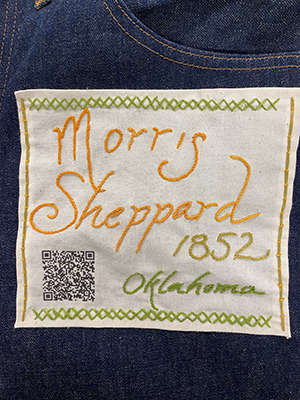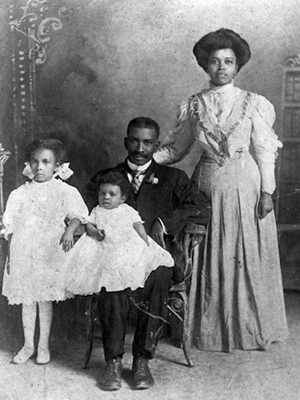Morris Sheppard
“Old Master tells me I was born in November 1852, at the old home place about five miles east of Webbers Falls, not far from the east bank of the Illinois River. Master’s name was Joe Sheppard, and he was a Cherokee Indian, slim and handsome. Pappy’s name was Caesar Sheppard and Mammy's name was Easter. I had two brothers, Silas and George, that belonged to Mr George Holt in Webber's Falls town. I got a pass and went to see them sometimes. My aunt did all the carding and spinning and my mammy did the weaving and cutting and sewing, and my pappy could make cowhide shoes with wooden pegs, they was for hard winter only. Everything was stripedy 'cause Mammy liked to make it fancy. She dyed with copperas and walnut and wild indigo and things like that and make pretty cloth. I wore a stripedy shirt till I was about eleven years old, and then one day while we was down in the Choctaw Country old Mistress see me and nearly fell off of her horse. She hollered, “Easter, you go right now and make that big buck of a boy some britches!” – Morris Sheppard
 Thabang Matona ’24
Thabang Matona ’24
Enslaved boys and girls were dressed in a simple tunic-type long shirt dress until they reached puberty, when they were then dressed in clothing deemed gender appropriate by white society (the men were given pants and the women dresses). In his autobiography, Frederick Douglass recalled wearing such a garment when he was young: “The children unable to work in the field had neither shoes, stockings, jackets, nor trousers, given to them; their clothing consisted of two coarse linen shirts per year. When these failed them, they went naked until the next allowance-day. Children from seven to ten years old, of both sexes, almost naked, might be seen at all seasons of the year.”
For hand-me-downs as well as diaper and potty training purposes, having all children wear the same type of garment was practical. This practice of outfitting both young boys and girls in dresses continued throughout the early twentieth century, until the advent of the ready- to-wear department stores who marketed “the romper.” When uneducated people today complain that only women should be allowed to wear dresses, they forget that men have been wearing gowns for longer than they’ve been wearing trousers. Before breeches were introduced from Persia during the late crusades, European men had worn draped garments for millenia.
Sources
- Federal Writers' Project: Slave Narrative Project, Vol. 13, Oklahoma, Adams-Young. 1936.
- Clothing the Black Body in Slavery: What They Wore and How it Was Made. | CUNY
- Clothing and Adornment of Enslaved People in Virginia
- Little Boys in Pink Dresses.
